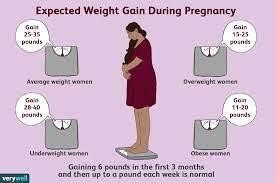A nurse is caring for a client at the first prenatal visit who has a BMI of 26.5. The client asks how much weight she should gain during pregnancy. Which of the following responses should the nurse make?
"A gain of about 1 pound per week is the best pattern for you."
"It would be best if you gained about 11 to 20 pounds."
"The recommendation for you is about 15 to 25 pounds."
"A gain of about 25 to 35 pounds is recommended for you."
The Correct Answer is C
Choice A: A weight gain of about 1 pound per week is a general guideline for women with normal BMI. However, for a client with a BMI of 26.5, the recommended weight gain during pregnancy may differ.
Choice B: Gaining 11 to 20 pounds may not be sufficient for a client with a BMI of 26.5, as the recommended weight gain is slightly higher for women with a higher prepregnancy BMI.
Choice C: For a client with a BMI of 26.5, the recommended weight gain during pregnancy is approximately 15 to 25 pounds. This range is specific to women with a BMI in the overweight category.
Choice D: Gaining 25 to 35 pounds is recommended for clients with a lower BMI range (normal BMI). For a client with a BMI of 26.5, this amount of weight gain may be excessive.

Nursing Test Bank
Naxlex Comprehensive Predictor Exams
Related Questions
Correct Answer is B
Explanation
A. Incorrect. Weightbearing exercises should be avoided or limited during pregnancy, as they can increase the risk of injury, joint pain, and fatigue.
B. Correct. Moderate exercise can improve circulation, reduce swelling, and prevent varicose veins during pregnancy.
C. Incorrect. Resting for 30 minutes before each new exercise is not necessary and may reduce the benefits of physical activity.
D. Incorrect. Stretching exercises can help prevent muscle cramps, improve flexibility, and reduce back pain during pregnancy.

Correct Answer is D
Explanation
A. "The test will be performed if your baby's heartbeat is heard."
Incorrect: Amniocentesis is not typically performed based on whether the baby's heartbeat is heard. It is done for specific diagnostic purposes, such as genetic testing or assessing certain fetal conditions.
B. "This test will determine if your baby's lungs are mature."
Incorrect: Amniocentesis does not determine fetal lung maturity. The test involves the extraction of a small amount of amniotic fluid to analyze fetal chromosomes and identify genetic conditions.
C. "After the test, you will be given Rh immune globulin since you are Rh positive."
Incorrect: Rh immune globulin (Rhogam) is given to Rhnegative pregnant women to prevent Rh sensitization, which occurs when an Rhnegative mother is exposed to
Rhpositive fetal blood. Rhogam is not directly related to amniocentesis.
D. "This test requires the presence of an adequate volume of amniotic fluid."
Correct: Amniocentesis requires a sufficient amount of amniotic fluid around the fetus for safe and accurate testing. If there is not enough amniotic fluid, the procedure may be postponed or canceled.
Whether you are a student looking to ace your exams or a practicing nurse seeking to enhance your expertise , our nursing education contents will empower you with the confidence and competence to make a difference in the lives of patients and become a respected leader in the healthcare field.
Visit Naxlex, invest in your future and unlock endless possibilities with our unparalleled nursing education contents today
Report Wrong Answer on the Current Question
Do you disagree with the answer? If yes, what is your expected answer? Explain.
Kindly be descriptive with the issue you are facing.
